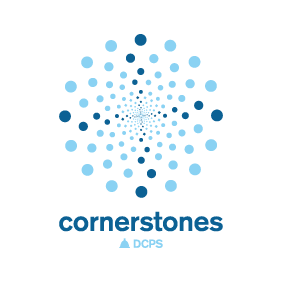Cornerstones and District-Wide Strategy
The Cornerstones Initiative is deeply rooted in the PELP Coherence Framework, developed by Harvard's Public Education Leadership Project. According to the Framework, an effective education reform strategy must simultaneously impact students, teachers, and content in order to be effective. Cornerstones are the lever for simultaneously engaging students and families, supporting great teaching, and improving the rigor and joy of content. Placing these strong, shared academic tasks at the heart of the instructional core became the critical 'if' in DCPS' Theory of Action.
Cornerstones Theory of Action
The Cornerstones Theory of Action, drafted following a framework from the Center for Public Research and Leadership, is a compact description of the components, outcomes, and impact of the Cornerstones Initiative.
Operationalize
Before implementing Cornerstones, DCPS assessed big-picture strengths, weaknesses, and potential challenges to realizing its theory of action and vision for tasks and PD. Existing structures, programs, and resources to support the work were identified, as were potential challenges. To roll out Cornerstones on a tight timeline, DCPS organized the project across 4 simultaneous work streams:
Source Cornerstone Tasks
The process of developing or identifying Cornerstone tasks is arguably the most complex phase of operationalizing - the tasks are what directly touch students, and what define the experience for many teachers. DCPS opted to build the majority of Cornerstone tasks in-house with a team of teachers from across the district, but also utilized high-quality tasks from a number of outside partners, including Engineering is Elementary, One World Education, and the Folger Shakespeare Library.
- Select an approach
- Create examples and exemplars
- Develop timeline and process
- Build a team
- Train and norm
- Create / Curate / Revise
Get Cornerstones Into the Classroom
After sourcing tasks and designing professional development, anticipating and overcoming challenges to robust classroom implementation presented the third key work stream of operationalizing. The manner in which Cornerstones are published and distributed depends on the structure of tasks and professional development, and influenced classroom delivery from the ordering of materials to the collection of student work. DCPS focused on three main objectives when getting Cornerstones tasks into the hands of teachers and managing the logistics around implementation.
- Publish
- Anticipate and solve for critical blockers
- Gather information and remain flexible
Design Professional Development
The process of designing meaningful professional learning experiences to support teachers is the second key aspect in Cornerstone implementation. PD can be used to support implementation in any number of ways, including: to prepare teachers for the Cornerstone tasks they’ll implement in the classroom; to support teachers in understanding and incorporating new, high-impact instructional models or academic content (which they’ll see reflected in the Cornerstones they use); to analyze student work products and norm on grade-level expectations; to continually improve and iterate Cornerstone tasks and curriculum.
- Craft objectives and strategies
- Create examples and exemplars
- Build a team
- Tackle logistics
- Anticipate bumps in the road
Communicate with Purpose
Sharing the Cornerstones story and strategy with a variety of stakeholders, from school leaders to families, presented both a challenge and an opportunity to highlight expanded opportunities for students and teachers district-wide. DCPS engaged families and community members through a number of outreach efforts, from school-based Cornerstone Nights, to district-wide Cornerstone showcases and poetry readings, to informational handouts.
- Craft a message
- Select strategies and begin building collateral
- Create a communications and events calendar
Reflect and Build
DCPS sought to collect data on Cornerstones implementation from multiple stakeholders, beginning with the first professional development session for teachers. Three main mechanisms for feedback are the professional development cycle, which incorporates teacher feedback and student work, teacher-facing mid-year and end of year surveys, and analyses of Cornerstones for revision opportunities and priorities. Teachers were invited to submit Cornerstones critiques, which influenced revision priorities.
Following data collection and reflection, DCPS established priorities for revision, including creation of the Quality Indicators rubric as part of a revised vision for tasks, and increased sustainability of materials, in addition to a growing focus on authenticity and excellence.




